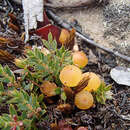en
names in breadcrumbs


Leucopogon fraseri is a species of flowering plant in the heath family Ericaceae and is native to south-eastern continental Australia and New Zealand, where it is known as Styphelia nesophila, pātōtara, or dwarf mingimingi.[2] It is a prickly, prostrate to trailing or low-growing shrub with egg-shaped leaves, and erect, tube-shaped white flowers usually arranged singly in leaf axils.
Leucopogon fraseri is a prickly, prostrate to trailing, low-growing shrub that typically grows to a height of up to 30 cm (12 in) and has bristly branchlets. Its leaves are egg-shaped to lance-shaped with the narrower end towards the base, 3–8 mm (0.12–0.31 in) long and 1–2.5 mm (0.039–0.098 in) wide. The leaves are glabrous, pale-edged, and have a thin, sharp point up to 1.5 mm (0.059 in) long on the tip. The flowers are usually arranged singly in leaf axils on a peduncle about 1 mm (0.039 in) long, with bracteoles 1.1–1.8 mm (0.043–0.071 in) long at the base. The sepals are 2.5–3.9 mm (0.098–0.154 in) long, the petals forming a tube 4–5 mm (0.16–0.20 in) long and hairy inside, the petal lobes 2.0–3.4 mm (0.079–0.134 in) long. Flowering occurs from August to October and the fruit is a glabrous, yellow, egg-shaped to elliptic drupe 4.7–5.3 mm (0.19–0.21 in) long.[2][3][4]
Leucopogon fraseri was first formally described in 1838 by Allan Cunningham in the journal, Annals of Natural History from a specimen found in 1820, "among ferns on the hills near the Bay of Islands" by Charles Fraser.[5][6]
This leucopogon grows in forest, shrubland and heath, often in poorly-drained or sandy soils or among rocks, and usually occurs at an altitude of above about 500 m (1,600 ft). It is found on the tablelands of northern and southern New South Wales, in eastern Victoria, on the Central Plateau of Tasmania, and in New Zealand.[2][3][4]
Leucopogon fraseri is listed as "not threatened" in New Zealand.[2]
The fleshy fruits are dispersed by frugivory.[7]
 Habit
Habit Leucopogon fraseri is a species of flowering plant in the heath family Ericaceae and is native to south-eastern continental Australia and New Zealand, where it is known as Styphelia nesophila, pātōtara, or dwarf mingimingi. It is a prickly, prostrate to trailing or low-growing shrub with egg-shaped leaves, and erect, tube-shaped white flowers usually arranged singly in leaf axils.